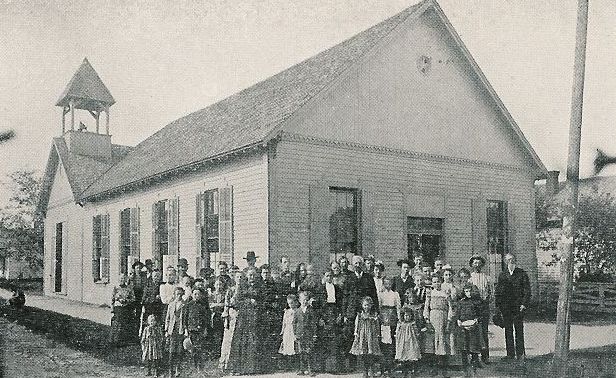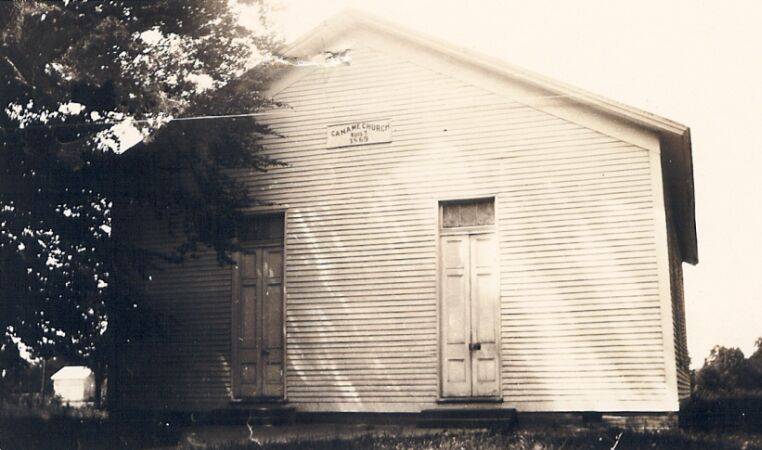Shelby County Indiana
Other Methodist Churches

The Methodist Reformed Church
From Boetcker's Picturesque Shelbyville, 1902, page 51.
----------
Aside from the Methodist Episcopal churches
named by Mrs. Hattie E. Robins [First Methodist Episcopal and West Street Methodist Episcopal], the
author has discovered the history of the following churches within the county,
a partial list of which she kindly furnished, while other data we secured
ourselves.Other Methodist Churches

The Methodist Reformed Church
From Boetcker's Picturesque Shelbyville, 1902, page 51.
----------
What was for many years known as the Boggstown Methodist church was organized at the house of Mr. Hough and later meetings were held at Adam McFaddenís, a mile to the south of the village. In 1850, a frame church was erected at Boggstown. In 1886 this church numbered eighty-six.
At Brandywine, in the autumn of 1827, at the home of Mrs. Seen, near Fairbank, a society was formed. Services were held until 1849 at private houses, including those of GC Hoarseness, the Detents, and Quinn. During that year (1849) a building was erected. Two parties of rough squatters, one on either side of the town, insisted on disturbing public worship, and joined one another in holding mock prayer meetings, in hearing of the services held by these pioneer Methodists, and when the settlers could no longer stand the abuse, the arose and soon put a stop to such lawlessness.
Sugar Creek (now Fairbank) was organized in 1847. The church at Fairbank, properly speaking, was formed in 1855. Thomas Hacker and family and Doctor Lewis and wife and a Mrs. Hopkins formed a class. A place of worship was provided and a Sunday School had been running some before the completion of the church building.
At Flatrock, in 1852, a frame church was erected by the Methodist people, three miles southwest of Norristown, near Gortonís Mills. The society worshiped here until 1870, when it moved to Flatwork station.
At Norristown a class was formed in 1866 by twelve members. In 1886 this church had a membership of ninety and worshiped in the old Union church.
At Marietta, in the forties, was organized a Methodist church. Services were at first held at private houses, but later in a school-house. About 1876 many members withdrew and helped from the Methodist Protestant church.
Morrison circuit was formed at an early date. Asbury church was he first organized on this circuit. Soon after land had been surveyed in 1822 a log cabin church was erected. It had a brick chimney and had its pulpit in one corner. Jonathan Johnson and family were prominent in this organization. Rev. John Stover was the first circuit rider there and a most excellent worker.
In 1839 a frame building was erected, at a cost of four hundred dollars. The present Morristown church was built in 1885. W. W. Woodyard was the architect and lived in the community until 1908, when he died. In 1886 it is recorded that the membership was ninety-five, but today they have two hundred members and in a flourishing condition. The cost of their present building was four thousand six hundred dollars. W. A. Bodine, an old merchant of the town, has ever been liberal in his support of this church, of which he is a worthy member today.
At Fountaintown a class was reorganized in 1857 and in 1876 a new church edifice was completed. In 1887 this was a thriving church, doing much good. Its first class leader was Isaac Robinson.
Pleasant Hill church was formed at the house of John Glenn, in 1830, and retained the name of Glennís Society for thirty years. Mr. Glenn was the first class leader. Near by, later on, a frame church was built. The society is still doing an excellent church work, but data is not at hand for this work of a county record.
At Waldron, the church was originally connected with that of Middletown and Connís Creek. It was established in 1836, with Frank Toler as a class leader. Connís Creek was organized in 1849, at the cross roads, now Waldron. The Knight family were prominent in this work. Also, the Van Pelts and Bliss families. School-hoses and private homes served until a church was erected, in 1858, when it took on the name of Waldron. Soon after that the society at Middletown abandoned the site and united at Waldron, making it a strong church. From an old record it appears that the following were officers in 1886: Trustees, J. J. Curtiss, Henry R. Ming, and A. H. Haymond; Stewards, Mrs. R. R. Washburn, Mrs. Elizabeth Washburn, and A. H. Haymond. The membership then was about fifty. At this date--1909--the membership is one hundred and forty-seven and the society is strong in influence for good in the community.
At a point on the Norristown pike that was named Winchester, a Methodist church was formed called Shadleyís Society. They met in the house of Mr. Hadley until 1848, then moved to the house of Thomas Maddy. In 1850, a frame house was built twenty-six by thirty-six feet. Prominent among the members were the Shadley family, Charles Thompson and wife. Mrs. John Monroe, T. H. Wherret and wife and Kitura Green. The frame church was replaced by a substantial brick building, dedicated in 1872. Among the active builders of this church were: Andrew Maple, Thomas Thompson, Job D. Tindall, John A. Gore, and John W. Wilson. In 1886 the church had a membership of eighty. It is still in the field.
Union Methodist church was formed by Rippleís class in 1833 and many years later called Union church. The first preaching was at an old settlerís house named Ripple. The class occupied a school-house until 1849, when a frame church was erected. Fifteen years later a new church was built, in 1864. The Greenís, McFall's, Foster's, and Jackson's were prominent in this organization. The church is still doing good service.
Tonerís Chapel, four miles from Shelbyville, is another Methodist point. Preaching commenced there in 1836. School-houses were used until 1845, when a frame building was erected. Services are still held at this place.
A church was formed at Geneva and a thousand dollar building erected there.
Canaan Methodist Episcopal church is located in Moral township, four miles south of Palestine. In an old frame building the early settlers by the score met and heard the word preached with old-time power.
Cynthianna church of this denomination was organized and a church built in 1854. Henry Fisher, Thomas Jones, William Fisher, J. N. Marshall and others were zealous in the work. The society never became large or very prosperous.
There is also a Methodist church at London, Shelby county. All in all, Methodism has sought out almost every nook and corner of this county, at one date or another, and hence has become a strong denomination today.
Chadwick's History of Shelby County, Indiana, by Edward H. Chadwick, B.A., assisted by well known local talent, B.F. Bowen & Co, Publishers: Indianapolis, IN, 1909, pages 154-157.
Submitted by Dean Glenn
Unknown Newspaper
Probably Clark or Scott County, Indiana
Unknown date
----------
Cana Church History Dates Back to 1801
----------
the history of Cana Church must necessarily take us back to the beginning of Methodism in Indiana.Probably Clark or Scott County, Indiana
Unknown date
----------
Cana Church History Dates Back to 1801
----------
The Kentucky District, which was the first district to include any Indiana territory was the Salt River and Shelby Circuit formed in 1801.
The first reliable record of Methodist preaching in Indiana was in 1801 at a settlement called Springfield, which was located in Clark's Grant. Two local preachers, Samuel Parker and Edward Talbott crossed the Ohio River and conducted a two day meeting.
In 1802 William McKendree, the presiding elder of the Kentucky District, had the honor of establishing the first official Methodist Classes ever formed in Indiana, one was at Charlestown and the other at New Chapple.
In 1803 Benjamin Larkin made arrangements to preach regularly at Charlestown and also at Robertson neighborhood just five miles north of Charlestown.
The Silver Creek Circuit was organized in 1807. It probably extended from Madison on the Ohio River west to Perry County and north to Brown, Bartholomew and Decatur counties, this included our county. This region had been in Salt River and Shelby Circuit.
Indiana Methodism now starts on its career. Camp meetings were held on each circuit at sometime during summer months. Moses Ashworth, the first circuit rider over this territory, closed his first year with a camp meeting in the Robertson neighborhood. This was probably the first camp meeting held in Indiana.
In 1808 a new district was added to the Western Conference and received the name of Indiana District, which was the first time the name Indiana appears in Methodist history.
Silver Creek Circuit appears in church minutes for the first time in 1808.
The summer of 1816 was cold and the supply of grain was very limited. As a result many people came down the Ohio River and settled in Dearborn, Jennings, Switzerland and Washington counties.
In 1836 a successful camp meting on the Paris Circuit added 84 members to that church.
The first mention found of Cana in minutes is on Paris Circuit in 1863, but in earlier years, the different appointments of circuit were not recorded, the numbers of churches was sometimes, but not always given. The Cana class must have started from Paris Circuit or very early in its history been added to that work.
Before a church was built, Sunday School, class meetings, prayer meetings and preaching services were held in an old log school house located on what is now known as Upper Cana Corner.
One hundred years ago, September 7, 1842, a piece of land was deeded to the Cana class as a building site for a church.
Copy of Deed
On September 7, 1842, James E. Wilson and Charlotte, his wife, deeded to Methodist Episcopal Church, before Daniel M. Hill, Justice of the Peace, a tract of land 13 poles, 5 feet and 6 inches, north and south, and 12 poles, east and west. This deed was recorded October 6, 1842.The trustees were:
George Wilson, Samuel A Kieth[sic], Andrew Wilson, Preston Stuart (Stewart), William Sage.
James E. Wilson, who deeded the land to the church, may be a brother of Campbell Wilson but I was unable to get dates of his birth and death ad the name of his wife. George Wilson is probably George Campbell Wilson (1815-1881) father of
(Continued on Last Page)
[I have yet to find the "Last Page" - PMF]Copied by Phyllis Miller Fleming
